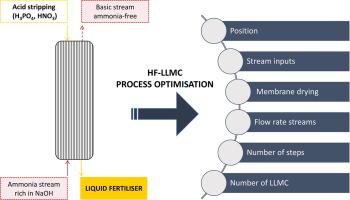Separation and Purification Technology ( IF 8.1 ) Pub Date : 2020-09-22 , DOI: 10.1016/j.seppur.2020.117768 M. Reig , X. Vecino , O. Gibert , C. Valderrama , J.L. Cortina

|
The transformation of wastewater treatment plants (WWTPs) to resources recovery plants (nutrients and energy) is forcing the development of specific technologies for selective recovery. Ion-exchange and hollow fibre liquid-liquid membrane contactors (HF-LLMCs) appeared as promising technologies to reduce operation costs, at ambient temperature, on the N-recovery from main-streams of urban WWTPs. A concentrated ammonia stream (4.5 g/L), recovered from treated wastewater using zeolites and NaOH, was used to test different operational parameters on the performance of the HF-LLMC process for ammonia recovery. These tested parameters were HF-LLMC position (horizontal and vertical), HF-LLMC feed and acid streams inputs (shell and lumen), type of acid stripping solution (0.4 M H3PO4 and 0.4 M HNO3), membrane drying, flow rate for each stream (263-770 mL/min), number of steps (1 and 2) and number of membrane contactors (1 and 2 in series). The maximum ammonia recovery (> 95%) was achieved by a one-step configuration using two vertical membrane contactors in series; using the shell side for feed stream and the lumen side for the acid stripping solution (HNO3); at 450 mL/min and 770 mL/min flow rates for feed and acid stripping solutions, respectively. The liquid fertiliser composition obtained was around 4.6% N (from NH4+). Additionally, the ammonia treated stream, rich in NaOH, had residual levels of NH3 (about 200 mg/L) that could be reused for the regeneration of the zeolites.
This optimized HF-LLMC process allowed to recover ammonia from a tertiary treatment solution of an urban WWTP and at the same time to produce ammonium salts that could be used as liquid fertilisers in irrigation applications. Therefore, this technology promotes the circular economy concept for nutrient recovery in urban WWTPs.
中文翻译:

中空纤维液-液膜接触器过程中氨气脱液的工艺参数研究
废水处理厂(WWTP)向资源回收厂(养分和能源)的转化正迫使特定选择性回收技术的发展。离子交换和中空纤维液-液膜接触器(HF-LLMC)似乎是有希望的技术,可降低城市污水处理厂主流氮回收的环境温度下的运行成本。使用沸石和NaOH从处理过的废水中回收的浓氨水(4.5 g / L)用于测试不同操作参数对HF-LLMC工艺进行氨回收的性能。这些测试参数是HF-LLMC位置(水平和垂直),HF-LLMC进料和酸料流输入(壳和管腔),酸汽提溶液的类型(0.4 MH 3 PO 4)和0.4 M HNO 3),膜干燥,每种物流的流速(263-770 mL / min),步骤数(1和2)和膜接触器数(串联的1和2)。通过使用两个串联的垂直膜接触器的一步配置,可以实现最大的氨回收率(> 95%)。将壳侧用于进料流,并将内腔侧用于酸汽提溶液(HNO 3);进料和酸汽提溶液的流速分别为450 mL / min和770 mL / min。获得的液体肥料组合物为约4.6%N(来自NH 4 +)。另外,富含NaOH的经氨处理的物流具有残余水平的NH 3(约200mg / L),可将其再用于沸石的再生。
通过优化的HF-LLMC工艺,可以从城市污水处理厂的三级处理溶液中回收氨,同时生产出铵盐,可用作灌溉应用中的液态肥料。因此,该技术提倡了循环经济概念,用于城市污水处理厂的养分回收。











































 京公网安备 11010802027423号
京公网安备 11010802027423号